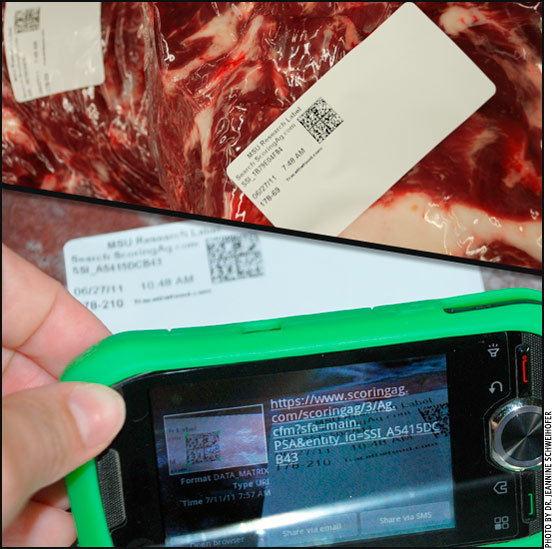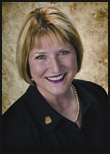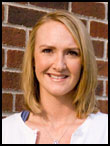MARKETING...

Smartphones and Steaks
Unless your steak was purchased from the farmer down the road, it can be hard to tell exactly where it came from, even if the sticker on the package says local.
Thanks to a new pilot program being conducted at Michigan State University (MSU), the day may soon be approaching where a quick barcode scan with a smartphone could tell the exact animal and farm where the steak originated.
In 2007, Michigan adopted a mandatory livestock tracing program — the only one of its kind in the nation — requiring that all cattle have a radio frequency identification (RFID) ear tag before leaving their original farm. The tags are designed to track the movement of Michigan's cattle herd and provide animal health officials with a tool to trace an individual animal back to where it was born. Now that the mandatory tracking system has been in place for four years, MSU researchers want to continue improving the system by continuing the traceability of information beyond just the processor. Read more.

Darrell Mark
In the Cattle Markets
Corn market volatility to continue.
Let's recap the corn acreage estimates thus far for 2011's crop. On March 31, the U.S. Department of Agriculture-National Agricultural Statistics Service (USDA-NASS) reported U.S. corn farmers intended to plant 92.2 million acres of corn this year. USDA's World Agricultural Outlook Board (WAOB) maintained that estimate in its May World Agricultural Supply and Demand Estimates (WASDE), despite significant delays in planting across the Corn Belt. USDA-WAOB did, though, drop planted acreage by 1.5 million acres to 90.7 million acres in its June 9 WASDE report, as many expected.Twenty-one days later, USDA-NASS released its June 30 acreage report, shocking most corn market participants by increasing corn planted acreage to 92.3 million acres amidst significant late planting, prevented planting, severe drought in the Southern Plains, and severe flooding across much of the Midwest Corn Belt. In the July 12 WASDE report, USDA-WAOB maintained this 92.3 million acres of corn planted in 2011. …
So, assuming that this volatility will continue, what should cattle feeders and other corn buyers do? Read more.
Culling Hard
Livestock producers are culling into the 'hearts of herds.'
Faced with lack of grazing, dwindling hay supplies and shrinking surface water sources, livestock producers continue to cull deeper into herds, according to Texas AgriLife Extension Service reports.
"They're culling a lot deeper than they normally would, and they're culling a lot harder than they normally would," said Rick Hirsch, AgriLife Extension agent for Henderson County, west of Tyler. "And they're culling into the heart of their herds."
By "heart of their herds," Hirsch meant heifers and 3- to 6-year-old cows that should form the core of future production. Read more.

Mary McMillen
CAB® 3QQ
Three quick questions with Mary McMillen.
Certified Angus Beef LCC (CAB) is a food company, with its fair share of experts in that field. There's the culinary team, meat scientists and people with backgrounds in foodservice, retail and packing. Surrounded by all that expertise, it might be surprising that the company's director of consumer marketing got her first taste of home economics (a degree she'd later earn from what's now Ashland University) mastering a needle and thread. Read more.
Dining Out is In Again
In this video news clip, Certified Angus Beef LLC's (CAB's) Mark Polzer, vice president for business development and a former foodservice professional, talks about the buying shift among consumers who turned to more retail purchases in the recession. They have turned back to dining out, which has made for more growth in foodservice sales of beef.

Sara Snider
The Source
AngusSource® calves continue to earn more.
The AngusSource program continues to add value to Angus-sired cattle, according to recent data from Western Video Market.
Western Video Market auction prices collected throughout 2010, show age- and source-verified calves sold through AngusSource earned higher prices compared to calves not age- and source-verified.
Calves enrolled in the American Angus Association's program, which documents source and group age of Angus-sired genetics, brought $2.57 more per cwt. than non-verified calves. Read more.
Traceability Name of Global Market
K-State ag economists discuss domestic and global beef demand trends at American Meat Science Association Reciprocal Meat Conference.
Some people might say the past 30 years have been unkind to the U.S. beef industry. Buffeted by a sharp drop in exports in 2004, stiff competition from a marketing-savvy poultry industry and occasional news of recalls, the industry continues to grapple with U.S. beef demand that is well below where it was 30 years ago, according to two Kansas State University (K-State) agricultural economists.
Glynn Tonsor, livestock marketing specialist with K-State Research and Extension, said beef consumption per capita in 2010 was 59.6 pounds (lb.), down from 76.6 lb. in 1980, while inflation-adjusted beef prices actually declined from 1980 to 2010. Tonsor, along with K-State distinguished professor of agricultural economics Ted Schroeder, spoke to scientists and students attending the recent American Meat Science Association Reciprocal Meat Conference hosted by K-State. Read more.
Angus Calendar
To view the Angus Calendar, a complete list of
Angus sales, click here.











